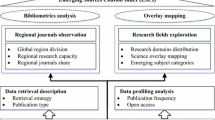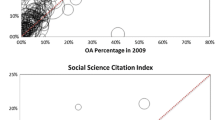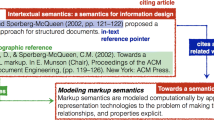Abstract
This study explores weighted author co-citation analysis (ACA) through a comparison of results from four weighted citation counting methods. The data set used comprises full-text research articles published in four top-tier library and information science (LIS) journals from 2011 to 2018. It finds that in-text frequency-weighted counting performs as well as traditional counting in identifying major dimensions of the LIS field but also shows more detail. Re-citation-based counting appears to highlight well-integrated specialties and weaken the presence of more fragmented ones compared to traditional counting. In-text frequency weighted re-citation counting, expected to highlight “deep” impact, appears to effectively zoom into the field to show intense streams of research within it, but fail to identify major dimensions of the field, essentially providing a telescopic view of the LIS field instead of the panoramic one that the other three methods provide. Measuring deep impact may be interesting and important for research evaluation but fails to retain the broader context that makes the visualizations of research fields so informative. It appears that what may be “noise” when considering impact of individuals can provide the context that allows us to see the forest for the trees when examining intellectual structures of research fields as in the case of traditional ACA.




Similar content being viewed by others
References
Bertin, M., & Atanassova, I. (2018). InTeReC: In-text reference corpus for applying natural language processing to bibliometrics. Retrieved April 18, 2019 from https://ceur-ws.org/Vol-2080/paper6.pdf.
Bertin, M., Atanassova, I., Gingras, Y., & Lariviere, V. (2016). The invariant distribution of references in scientific articles. Journal of the Association for Information Science and Technology,67(1), 164–177.
Bertram, S. (1972). Citations counts. In A. Pitemick (Ed.), Proceedings of the fourth annual meeting of the american society for information science, Western Canada Chapter (pp. 61–67). Vancouver: University of British Columbia.
Bonzi, S. (1982). Characteristics of a literature as predictors of relatedness between cited and citing works. Journal of the American Society for Information Science,33, 208–216.
Borgman, C. L., & Furner, J. (2002). Scholarly communication and bibliometrics. Annual Review of Information Science and Technology,36, 3–72.
Bornmann, L., & Daniel, H.-D. (2008). What co-citation counts measure? A review of studies on citing behavior. Journal of Documentation,64, 45–80.
Boyack, K. W., Small, H., & Klavans, R. (2013). Improving the accuracy of co-citation clustering using full text. Journal of the American Society for Information Science and Technology,64(9), 1759–1767.
Boyack, K. W., Van Eck, N. J., Colavizzac, G., & Waltman, L. (2018). Characterizing in-text citations in scientific articles: A large-scale analysis. Journal of Informetrics.,12(1), 59–73.
Brooks, T. A. (1985). Private acts and public objects: An investigation of citer motivations. Journal of the American Society for Information Science,36(4), 223–229.
Brooks, T. A. (1986). Evidence of complex citer motivations. Journal of the American Society for Information Science,37(1), 34–36.
Bu, Y., Wang, B. L., Huang, W. B., Che, S. K., & Huang, Y. (2018). Using the appearance of citations in full text on author co-citation analysis. Scientometrics,116, 275–289.
Callahan, A., Hockema, S., & Eysenbach, G. (2010). Contextual cocitation: Augmenting cocitation analysis and its applications. Journal of the American Society for Information Science and Technology,61(6), 1130–1143.
Cano, V. (1989). Citation behavior—Classification, utility, and location. Journal of the American Society for Information Science,40, 284–290.
Case, D. O., & Higgins, G. M. (2000). How can we investigate citation behavior? A study of reasons for citing literature in communication. Journal of the American Society for Information Science,51(7), 635–645.
Chubin, D. E., & Moitra, S. D. (1975). Content analysis of references: Adjunct or alternative to citation counting? Social Studies of Science,5(4), 423–441.
Ding, Y., Liu, X., Guo, C., & Cronin, B. (2013). The distribution of references across texts: Some implications for citation analysis. Journal of Informetrics,7(3), 583–592.
Elkiss, A., Shen, S., Fader, A., Erkan, G., States, D., & Radev, D. (2008). Blind men and elephants: What do citation summaries tell us about a research article? Journal of the American Society for Information Science and Technology,59(1), 51–62.
Fegley, B. D., & Torvik, V. I. (2013). Has large-scale named-entity network analysis been resting on a flawed assumption? PloS Once,8(7), e70299. https://doi.org/10.1371/journal.pone.0070299.
Garfield, E. (1979). Citation indexing—Its theory and application in science, technology, and humanities. New York: Wiley.
Gipp, B., & Beel, J. (2009). Citation Proximity Analysis (CPA)—A new approach for identifying related work based on co-citation analysis. Proceedings of the 12th International Conference on Scientometrics and Informetrics (ISSI’09) (pp. 571–575).
Hair, J. F., Anderson, R. E., Tatham, R. L., & Black, W. C. (1998). Multivariate data analysis (5th ed.). Upper Saddle River, NJ: Prentice Hall.
Hanney, S., Frame, I., Grant, J., Buxton, M., Young, T., & Lewison, G. (2005). Using categorizations of citations when assessing the outcomes of health research. Scientometrics,65, 357–379.
Harzing, A. W. (2015). Health warning: might contain multiple personalities—the problem of homonyms in Thomson Reuters Essential Science Indicators. Scientometrics,105(3), 2259–2270.
Herlach, G. (1978). Can retrieval of information from citation indexes be simplified? Multiple mention of a reference as a characteristic of the link between cited and citing article. Journal of the American Society for Information Science,29(6), 308–310.
Hou, W., Li, M., & Niu, D. (2011). Counting citations in texts rather than reference lists to improve the accuracy of assessing scientific contribution. BioEssays,33, 724–727.
Hsiao, T.M., & Chen, K.H. (2018). How authors cite references? A study of characteristics of in-text citations. ASIST Proceedings,55(1), 179–187.
Hu, Z., Lin, G., Sun, T., & Hou, H. (2017). Understanding multiply mentioned references. Journal of Informetrics,11(4), 948–958.
Jeong, Y. K., Song, M., & Ding, Y. (2014). Content-based author co-citation analysis. Journal of Informetrics,8(1), 197–211.
Kim, J., & Diesner, J. (2016). Distortive effects of initial-based name disambiguation on measurements of large-scale coauthorship networks. Journal of the Association for Information Science and Technology,67, 1446–1461.
Liu, M. (1993). The complexities of citation practice: A review of citation studies. Journal of Documentation,49, 370–408.
Liu, S., & Chen, C. (2012). The proximity of co-citation. Scientometrics,91(2), 495–511.
McCain, K. W., & Turner, K. (1989). Citation context analysis and aging patterns of journal articles in Molecular-Genetics. Scientometrics,17, 127–163.
Moravcsik, M. J., & Murugesan, P. (1975). Some results on the function and quality of citations. Social Studies of Science,5(1), 86–92.
Narin, F. (1976). Evaluative bibliometrics: The use of publication and citation analysis in the evaluation of scientific activity. Washington, DC: Computer Horizons.
Otto, W., Ghavimi, B., Mayr, P., Piryani, R., Singh, V.K. (2019). Highly cited references in PLOS ONE and their in-text usage over time. Retrieved April 18, 2019 from ArXiv.org.
Pak, C., Yu, G., & Wang, W. (2018). A study on the citation situation within the citing paper: citation distribution of references according to mention frequency. Scientometrics,114(3), 905–918. https://doi.org/10.1007/s11192-017-2627-0.
Qiu, J. (2008). Scientific publishing: Identity crisis. Nature News,451(7180), 766–767.
Shadish, W. R., Tolliver, D., Gray, M., & Gupta, S. K. S. (1995). Author judgements about works they cite: Three studies from psychology journals. Social Studies of Science,25(3), 477–498.
Small, H. (1982). Citation context analysis. In B. J. Dervin & M. J. Voigt (Eds.), Progress in communication sciences (Vol. 3, pp. 287–310). Norwood: Ablex.
Strotmann, A., & Zhao, D. (2012). Author name disambiguation: What difference does it make in author-based citation analysis? Journal of the American Society for Information Science and Technology,63(9), 1820–1833.
Strotmann, A., & Zhao, D. (2015). An 80/20 data quality law for professional scientometrics? Proceedings of the 15th International Society for Scientometrics and Informetrics Conference, June 30–July 3, 2015, Istanbul, Turkey.
Tang, R., & Safer, M. A. (2008). Author-rated importance of cited references in biology and psychology publications. Journal of Documentation,64, 246–272.
Thelwall, M. (2019a). Should citations be counted separately from each originating section? Journal of Informetrics. Retrieved June 2019, from https://arxiv.org/pdf/1903.07547.pdf.
Thelwall, M. (2019). The rhetorical structure of science? A multidisciplinary analysis of article headings. Journal of Informetrics.,13(2), 555–563.
Vinkler, P. (1987). A quasi-quantitative citation model. Scientometrics,12(1), 47–72.
Voos, H., & Dagaev, K. S. (1976). Are all citations equal? Or Did we op. cit. your idem? Journal of Academic Librarianship,1, 20–21.
White, H. D. (1990). Author co-citation analysis: Overview and defense. In C. L. Borgman (Ed.), Scholarly communication and bibliometrics (pp. 84–106). Newbury Park: Sage.
White, H. D., & McCain, K. W. (1998). Visualizing a discipline: An author co-citation analysis of information science, 1972–1995. Journal of the American Society for Information Science,49, 327–355.
White, H. D., & Wang, P. L. (1997). A qualitative study of citing behavior: contributions, criteria, and meta-level documentation concerns. Library Quarterly,67, 122–154.
Zhao, D., Cappello, A., & Johnston, L. (2017). Functions of uni-and multi-citations: Implications for weighted citation analysis. Journal of Data and Information Science,2(1), 51–69.
Zhao, D., & Strotmann, A. (2008a). Information Science during the first decade of the Web: An enriched author co-citation analysis. Journal of the American Society for Information Science and Technology,59(6), 916–937.
Zhao, D., & Strotmann, A. (2008b). Evolution of research activities and intellectual influences in Information Science 1996–2005: Introducing author bibliographic coupling analysis. Journal of The American Society for Information Science and Technology,59(13), 2070–2086.
Zhao, D., & Strotmann, A. (2008c). Comparing all-author and first-author co-citation analyses of Information Science. Journal of Informetrics,2(3), 229–239.
Zhao, D., & Strotmann, A. (2011). Intellectual structure of Stem Cell research: A comprehensive author co-citation analysis of a highly collaborative and multidisciplinary field. Scientometrics,87(1), 115–131.
Zhao, D., & Strotmann, A. (2014). In-text author citation analysis: Feasibility, benefits and limitations. Journal of the Association for Information Science and Technology,65(11), 2348–2358. https://doi.org/10.1002/asi.23107.
Zhao, D., & Strotmann, A. (2014). The knowledge base and research front of Information science 2006–2010: An author co-citation and bibliographic coupling analysis. Journal of the Association for Information Science and Technology,65(5), 996–1006.
Zhao, D., & Strotmann, A. (2015). Analysis and visualization of citation networks. San Rafael: Morgan & Claypool Publishers. https://doi.org/10.2200/S00624ED1V01Y201501ICR039.
Zhao, D., & Strotmann, A. (2015b). Re-citation analysis: Promising for research evaluation, knowledge network analysis, knowledge representation and information retrieval? Proceedings of the 15th International Society for Scientometrics and Informetrics Conference, June 30–July 3, 2015, Istanbul, Turkey.
Zhao, D., & Strotmann, A. (2016). Dimensions and uncertainties of author citation rankings: Lessons learned from frequency-weighted in-text citation counting. Journal of the Association for Information Science and Technology,67(3), 671–628.
Zhu, X., Turney, P., Lemire, D., & Vellino, A. (2015). Measuring academic influence: Not all citations are equal. Journal of the Association for Information Science and Technology,66(2), 408–427.
Author information
Authors and Affiliations
Corresponding author
Appendix
Appendix
Python regular expressions for identifying in-text citations and their components.
# In-text reference publication year, possibly plus disambiguating lower case letter:
pubyearRE = r'(?:[12][0189]\d\d[a-z]?)'
# Multiple publication years (for the same authors):
pubyearsRE = r'(?:(?:' + pubyearRE + ',\s +)*' + pubyearRE + r')'
# Page numbers within an intext reference (to be recognized but ignored):
pageRE = r'(?:\bpp?\.\s + (\d +|[iIvVxXlLdDmM] +)(?:[-](\d +|[iIvVxXlLdDmM] +))?)'
# Possible introductory phrase within reference block parentheses (to be recognized but ignored):
egRE = r'(?:e[.]g[.],?\s +)?'
# Frequent name prefixes that may appear in lower-case in an author name:
namePrefixRE = r"(?:al|da|dal|dalle|de|del|della|den|der|des|det|el|van|von|y|zu|zum|zur)"
# A name component is a series of capitalized words possibly prefixed by a lower-case prefix:
nameComponentRE = r'(?:' + namePrefixRE + r"\s +)*(?:(?:[dtlO]')?[A-Z]\w*)"
# A full last name is composed of name components separated by hyphens:
nameRE = r'(?:' + nameComponentRE + r'(?:(\s +|-)' + nameComponentRE + r')*)'
# Author names (one or more) flowing with the text:
namesREintext = r'((((((' + nameRE + r'\s +)|((?:' + nameRE + r',\s +) +))and\s +)?)' + nameRE + r')|(' + nameRE + r',?\s + et\s + al\.))'
# Full reference flowing in the text – authors, years, pages:
refREintext = r'(\s + ' + namesREintext + r"([']s)?" + r'\s + \(' + pubyearsRE + r'(?:,\s + ' + pageRE + r')?\))'
# Author names in a parenthetic citation block:
namesREinpar = r'(((?:(?:' + nameRE + r'|(?:' + nameRE + r',\s +)*)\s*(\&|and)\s +)*' + nameRE + r')|(' + nameRE + r',?\s + et\s + al\.))'
# individual reference formats for first and for subsequent reference within a citation block:
refREinpar = r'(' + namesREinpar + r',\s + ' + pubyearsRE + r'(?:,\s + ' + pageRE + r')?)'
refREinpar2 = r'((?:' + namesREinpar + r',\s +)?' + pubyearsRE + r'(?:,\s + ' + pageRE + r')?)'
# Complete reference block enclosed in parentheses:
refsREwithpar = r'(\(' + egRE + refREinpar + r'(?:;\s + ' + refREinpar2 + r')*\))'.
# The full regular expression for the two types of in-text references – separated by parentheses or flowing with the text:
refsRE = r'(' + refREintext + r'|' + refsREwithpar + r')'
Rights and permissions
About this article
Cite this article
Zhao, D., Strotmann, A. Telescopic and panoramic views of library and information science research 2011–2018: a comparison of four weighting schemes for author co-citation analysis. Scientometrics 124, 255–270 (2020). https://doi.org/10.1007/s11192-020-03462-0
Received:
Published:
Issue Date:
DOI: https://doi.org/10.1007/s11192-020-03462-0




